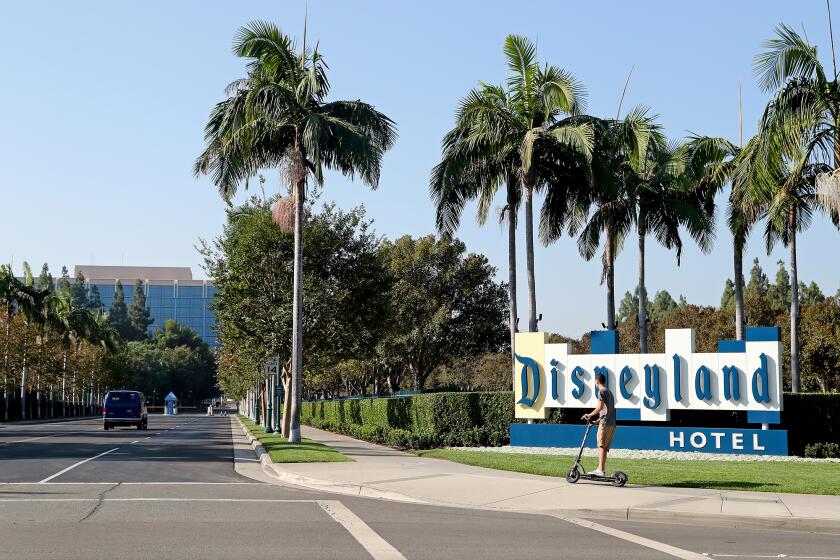Orange County philanthropist helped save crucial Mexican lagoon used by gray whales for breeding
When the last undeveloped lagoon in Mexico that was crucial for gray whale migration was threatened with a giant salt production plant, the heiress of an oil tycoon’s fortune stepped up.
Orange County-based Anne Earhart, granddaughter of famed oil magnate John Paul Getty, played an integral role in fueling conservation efforts that saved the San Ignacio Lagoon nearly 20 years ago.
Earhart was recently named a recipient of the 2019 Carnegie Medal of Philanthropy for her environmental work.
The lagoon is known for being a refuge for gray whales to breed during their annual migration between Mexico and Alaska. The surrounding area has remained pristine, where pronghorn antelope, bighorn sheep and mountain lions roam in the untouched, unpolluted wild. Small settlements of fishermen surround the lagoon.
But the lagoon’s natural integrity was once threatened when Japanese corporation Mitsubishi and the Mexican government decided to move forward on a $180-million salt-evaporation plant on the edge of the 17-mile-long lagoon in 1995. With Mexico struggling economically, a plant that could create 200 jobs and $100 million in exports was tempting, even if it would spoil the last undeveloped gray whale sanctuary in Mexico.
“This was the wrong place for this kind of project,” Earhart said.
Earhart became familiar with the lagoon while taking surfing trips to Baja California in her 20s.
“Seeing the whales,” Earhart said. “That whet my appetite, and I was able to find a camp down in the San Ignacio Lagoon and fly down there and see gray whales in their last undisturbed lagoon. I have been returning there to this day.”
So when she heard the pristine lagoon was being threatened with development, Earhart jumped at the chance to get involved in what ended up being a five-year battle with Mitsubishi and the Mexican government.
Famed Mexican fisherman Don Pachico Mayoral, who holds near-mythical status in the country as the rumored first man to ever touch a gray whale, first handed Serge Dedina, the current mayor of Imperial Beach, the blueprints to the salt production project.
Dedina, who had been at the lagoon while studying gray whale conservation for his PhD., alerted Earhart, and Earhart’s Laguna Beach-based organization, the Marisla Foundation, joined with other environmentalist groups in the United States and Mexico to form a coalition.
Dedina, whose nonprofit Wildcoast works closely with Earhart, said the three main organizations that rallied around the cause were the National Resources Defense Council, the International Fund for Animal Welfare and the Mexico-based Group of 100 — a collaboration of artists and intellectuals fighting for environmental causes.
The effort became even more important in late 1997 after endangered giant black sea turtles were fatally poisoned by a spill of toxic salt brine from a plant run by the Mitsubishi-owned corporation, Exportadora de Sal S.A., in the nearby Guerrero Negro lagoon.

The strategy to counter Mitsubishi and the Mexican government partly relied on an international campaign to bring attention to the cause. Various celebrities were involved, including actor Pierce Brosnan and Portuguese Nobel Laureate Jose Saramago. Robert F. Kennedy Jr. published an article against the project in the Los Angeles Times in 1998.
“It was getting people to care all around the world, especially the U.S. and Mexico, about this isolated lagoon in Baja, in the middle of nowhere, filled with these amazing whales,” Dedina said. “We had to get people to understand that it’s something like the Mona Lisa — it’s irreplaceable.”
The environmental groups worked to put pressure on the Mexican government and supported local activists and community organizations.
The fishermen and whale watching guides who relied on the lagoon for their livelihood were a powerful force in the fight.
“The challenge was fear and intimidation,” Dedina said. “Fear, especially when you live in the middle of nowhere and you are a fisherman and make your living whale watching and fishing. You don’t have a telephone or electricity and maybe you have a grade school education, yet you’re standing up to the president of Mexico and the Mitsubishi corporation.
“The Mexican head of the salt company was really like the godfather of central Baja. You are battling these incredibly powerful forces. That was the biggest thing, really getting people to overcome that fear and intimidation and getting to stand up.”
But the fishermen and whale watching guides had to either fight or face the death of their livelihood.
“The total value of the regional economy was dependent on lagoon fisheries in the immediate area and whale watching,” Dedina said. “It was one of the first fisheries to be a community-based fishery.
“It was really important having these authentic voices on the ground to amplify the message. They said, ‘Look, I make my living from this. This project is going to kill our community and way of life.’”
Dedina said Earhart really helped fuel the on-ground efforts with her financial backing and unwavering support to take on the big forces behind the project.
“She’s like having that person on the beach when those waves are big, who says, ‘Paddle out, go for it,’” Dedina said. “Forcing us to charge. She is always there for you when you are an activist in a heavy situation.”
Established in 1986, Earhart’s Marisla Foundation has funded more than 600 nonprofits — many of them working toward environmental causes.
After a hard fight, then-Mexican President Ernesto Zedillo withdrew support for the project, and it was scrapped in early 2000. Zedillo’s announcement came a week after he visited the lagoon and took a boat out to see the gray whales.
“I think this community — there is something special about it,” said Sara Lowell, board member and marine program director for the Marisla Foundation. “They really saw not only the economic value of having an intact ecosystem but also the intrinsic value of it. They take their role of being stewards of this area very seriously. Even though there was talk about jobs being offered by the salt plant, they chose to continue the work that they were doing, both fishing and leading whale watching tours over these other jobs.”

Since the lagoon was saved, it’s been discovered that it’s even more crucial for Mexico. The lagoon’s mangroves and seagrass are important absorbents of carbon.
“San Ignacio and others like it have become ground zero in Mexico’s efforts to address climate change through natural solutions,” Dedina said.
San Ignacio Lagoon now hosts a healthy, sustainable tourism industry.
Through a series of land deals and conservation concessions, Dedina’s organization, the Marisla Foundation and others have protected about 450,000 acres around the lagoon. Wildcoast is also working on restoring mangroves.
All the latest on Orange County from Orange County.
Get our free TimesOC newsletter.
You may occasionally receive promotional content from the Daily Pilot.




